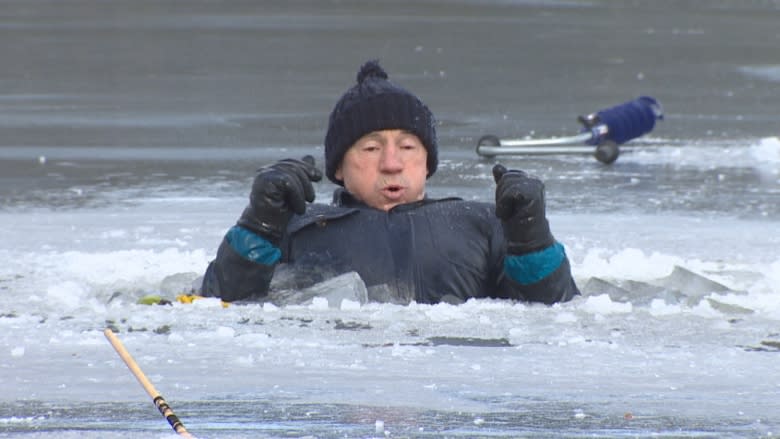Staying alive: How to survive a fall through the ice
Would you know what to do if you saw someone fall through the ice? What about if you fell through?
CBC Newfoundland and Labrador teamed up with Rovers Search and Rescue for a demonstration, and staged three scenarios on a pond in Torbay.
Are you alone?
Paul French, a volunteer with Rover's ice water rescue team, says the first and most important thing to do is to get your breathing under control — and you have about one minute to do it.
From there, French estimates you have 10 minutes of "meaningful movement." Meaning, if you're not able to get to safety within 10 minutes, the priority is to conserve energy and body heat.
If you can get out and get help within 10 minutes, start moving:
- Get as much of your body out of the water as possible. Curling up in a fetal position will help conserve body heat.
- Turn around and face the direction you came from. The ice held your weight on the way in, chances are it'll hold your weight on the way out.
- Kick your feet as much as possible. Keep kicking until your body is horizontal with the ice.
- Once you're out of the water, stay low and roll to safety.
The 1-10-1 principal: Take one minute to control your breathing. You have 10 minutes of meaningful movement. You have one hour before hypothermia sets in.
Have a set of ice picks
In the second scenario, the fishermen was wearing a set of ice picks — a tool French recommends everyone have.
"Once you fall through, the ice is slippery and you have absolutely no grip … you really dig [the picks] into the ice and you can grab your way out."
French suggests making a pair of picks at home with an old set of screwdrivers.
"Just cut them off, throw a rope on each side. I drilled two holes to keep [the sharp ends] concealed … anybody can make these at home, everybody's got this stuff around," he says.
Have a buddy
In the third scenario, the fisherman wasn't alone. Instead, a friend grabbed a nearby tree branch to pull the man from the water.
French again stresses the importance of the rescuer staying low and spreading their weight out over the surface of the ice.
The person in the water can use the outstretched branch or object to establish a grip and pull themselves out, while their friend pulls them to safety.



